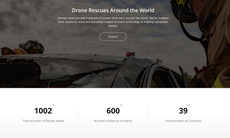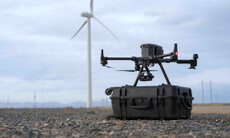DJI Supports Major Test Of Drone Airspace Integration
DJI AeroScope Remote Identification Enables Unmanned Traffic Management Trial
November 21, 2018 – DJI, the world’s leader in civilian drones and aerial imaging technology, today demonstrated how its AeroScope remote identification technology can be a key element in an unmanned traffic management (UTM) system that safely integrates drones and traditional aircraft into the same airspace.
The AeroScope solution was featured in Operation Zenith, a full-scale test of how a UTM system can enable beneficial uses of drones in controlled airspace while helping monitor unauthorized or uncooperative drone activities. Operation Zenith demonstrated eight scenarios in which drones successfully worked in concert with traditional aircraft movements at Manchester Airport in the United Kingdom.
Operation Zenith was led by the aviation technology company Altitude Angel, as well as Manchester Airport and NATS, the UK’s leading provider of air traffic control services, and included a wide range of government, industry and academic participants. On the technology side, it featured Altitude Angel’s GuardianUTM O/S platform, which gathers data from a range of sources to provide full drone UTM services alongside traditional air traffic management, and which integrates AeroScope data to provide awareness of drone operations. Commercially, NATS showed how air navigation service providers can play a role in providing fair and equitable access to airspace for all airspace users.
“DJI is committed to innovating new technology to help ensure drones remain a safe and beneficial addition to the airspace. That commitment is clear with DJI’s AeroScope system, and we are excited to see how AeroScope’s capabilities can support a robust UTM platform,” said Christian Struwe, DJI Head of Public Policy EMEA. “Altitude Angel’s vision of a common platform for a wide range of drone and traditional aircraft operations is an exciting step forward, and we are pleased to work with other Operation Zenith partners to bring this vision to life. This shows the way forward for UTM and the EU wide U-space initiative.”
AeroScope functions as an electronic license plate for drones. It uses the existing communications link between a DJI drone and its remote controller to transmit basic identification, such as a registration or serial number, as well as telemetry data including location, altitude, speed and direction. Police, national security and aviation safety officials can use an AeroScope receive to monitor those signals and plot them on a map, giving them the ability to monitor, analyze and act on that information in real time.
“Today’s test shows that DJI’s AeroScope can be a valuable part of a UTM system by monitoring and tracking airborne drones arund sensitive locations, reliably and rapidly feeding that information to an integrated airspace manager, and enabling a flexible model that adapts instantly to new information about aerial operations,” said Brendan Schulman, DJI Vice President of Policy & Legal Affairs. “DJI is proud to contribute to this broad-based effort to find smart solutions for opening up controlled airspace to the benefits of drones.”
AeroScope is already in use at airports, major public arenas and large public gatherings around the world. Because it receives signals directly from drones using their existing communications link, rather than relying on a wireless network or special transmitters, it is ideal for capturing critical airspace information for a UTM system to process.


